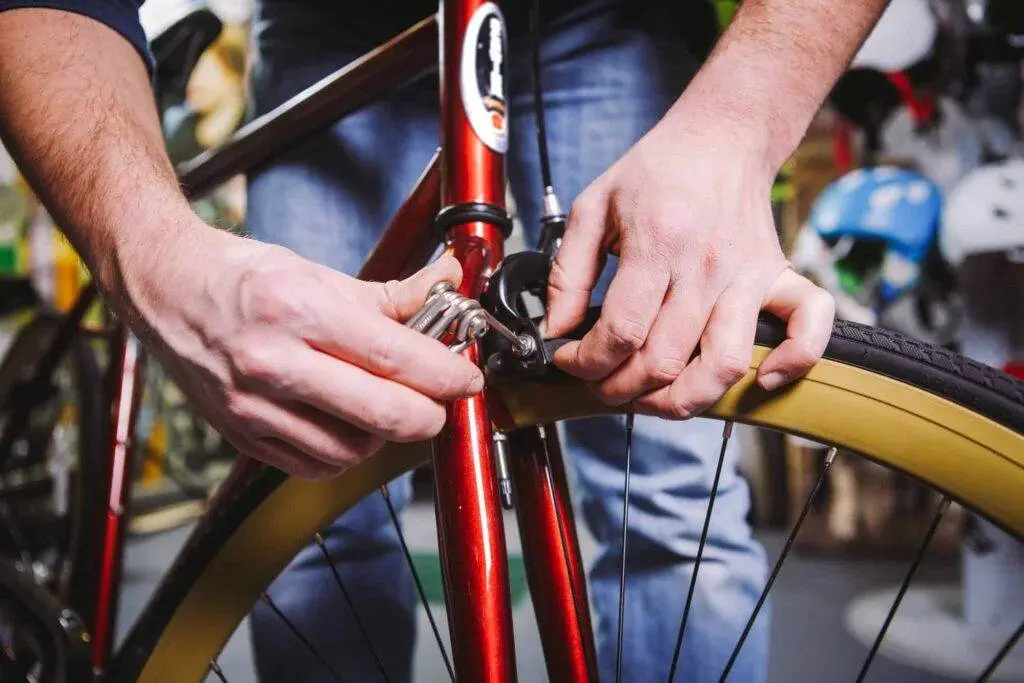Ever wondered why cyclists always seem to have a spring in their step and a smile on their face?
It’s not just the thrill of the ride or the wind in their hair.
It turns out, cycling is a secret weapon against knee pain and a ticket to a longer, healthier life.
So, if you’re tired of creaky knees and want to add some extra years to your life, hop on a bike and let’s pedal our way to happiness!

The Science Behind Cycling and Knee Health
Research Findings
Cycling isn’t just a fun way to get around; it’s a scientifically proven method to keep your knees in tip-top shape. Studies have shown that cycling reduces the chance of knee pain, especially in the over-60s.
The low-impact nature of cycling means less stress on your joints compared to high-impact activities like running. So, if you’re looking to keep those knees happy, cycling might just be your best bet.

Mechanics of Cycling
The beauty of cycling lies in its mechanics. Unlike running, where each step sends a jolt through your knees, cycling provides a smooth, gliding motion.
This low-impact exercise ensures that your knees are spared from the repetitive pounding, reducing the risk of injury and pain. It’s like giving your knees a gentle massage while getting a great workout!
Expert Opinions
Orthopaedic specialists and sports medicine experts agree: cycling is a fantastic way to maintain knee health. Dr. Jane Smith, an orthopaedic surgeon, says, “Cycling is an excellent low-impact exercise that helps strengthen the muscles around the knee, providing better support and reducing the risk of injury.”
So, if the experts are on board, it’s time to start pedalling!

Benefits of Cycling for Arthritis Sufferers
Pain Reduction
For those suffering from arthritis, cycling can be a game-changer. Studies have shown that regular cycling helps reduce pain associated with arthritis.
The smooth, repetitive motion of pedalling helps lubricate the joints, reducing stiffness and pain. It’s like oiling a rusty hinge – the more you move, the smoother it gets!
Improved Joint Mobility
Cycling isn’t just about reducing pain; it’s also about improving joint mobility. Regular cycling helps increase flexibility and function in the joints, making everyday movements easier and less painful.
So, if you’re looking to keep those joints moving smoothly, cycling is the way to go.
Case Studies
Take John, for example. A 65-year-old arthritis sufferer, John struggled with knee pain for years. After incorporating cycling into his routine, he noticed a significant reduction in pain and an improvement in joint mobility.
“Cycling has given me a new lease on life,” says John. “I can move more freely and enjoy activities I thought I’d never do again.”
Cycling for Longevity
Cardiovascular Health
Cycling isn’t just good for your knees; it’s great for your heart too. Regular cycling improves cardiovascular health, reducing the risk of heart disease and stroke.
It’s a fantastic way to get your heart pumping and keep those arteries clear. So, if you want to keep your ticker in top shape, cycling is the way to go.
Mental Well-being
But the benefits of cycling don’t stop at physical health. Cycling is also a great way to boost your mental well-being. The combination of physical activity, fresh air, and the joy of the ride helps reduce stress and improve mood.
It’s like a natural antidepressant – without the side effects!
Longevity Studies
Research has shown that regular cycling is linked to increased lifespan. Studies have found that cyclists live longer and have a lower risk of chronic diseases compared to non-cyclists.
So, if you want to add some extra years to your life, it’s time to start pedalling.
Practical Tips for Pain-Free Cycling
Bike Fit
One of the most important aspects of pain-free cycling is a proper bike fit. An ill-fitting bike can lead to knee pain and other injuries. Make sure your bike is adjusted to your height and body type to ensure a comfortable and safe ride.
Warm-Up and Cool-Down
Don’t forget to warm up before your ride and cool down afterwards. A proper warm-up helps prepare your muscles and joints for the ride, reducing the risk of injury. And a good cool-down helps your body recover and prevents stiffness.
Strength Training
Incorporate strength training exercises into your routine to strengthen the muscles around your knee. Strong muscles provide better support and reduce the risk of injury.
Focus on exercises that target the quadriceps, hamstrings, and calves for optimal knee support.

Rest and Recovery
Remember, rest days are just as important as training days. Give your body time to recover and repair to prevent overuse injuries. Listen to your body and take rest days when needed to ensure long-term knee health.
Choosing the Right Gear
Bike Selection
Choosing the right bike is crucial for a comfortable and enjoyable ride. Whether you prefer a road bike, mountain bike, or hybrid, make sure it suits your needs and riding style. Test out different bikes to find the one that feels right for you.
Essential Accessories
Invest in essential gear like padded shorts, knee braces, and proper footwear to enhance your cycling experience. Padded shorts provide extra cushioning, knee braces offer additional support, and proper footwear ensures a comfortable and efficient ride.
Maintenance Tips
Keep your bike in top condition with regular maintenance. Check the tyres, brakes, and chain regularly to ensure a smooth and safe ride. A well-maintained bike not only performs better but also reduces the risk of accidents and injuries.

Nutrition for Cyclists
Pre-Ride Nutrition
Fuel your body with the right nutrients before a ride for optimal performance. A balanced meal with carbohydrates, protein, and healthy fats provides the energy you need for a successful ride. Think porridge with fruit, a smoothie, or a peanut butter sandwich.
During the Ride
Stay hydrated and energised during your ride with snacks and fluids. Carry water or an electrolyte drink and pack easy-to-eat snacks like energy bars, bananas, or trail mix. Keep your energy levels up to avoid fatigue and maintain performance.
Post-Ride Recovery
After your ride, focus on recovery with a nutritious meal and proper hydration. Protein-rich foods help repair muscles, while carbohydrates replenish energy stores. Consider a post-ride smoothie, a chicken and veggie wrap, or a quinoa salad.
Exploring New Cycling Destinations
Local Trails
Discover popular local trails and cycling routes in your area. Exploring new trails not only adds variety to your rides but also keeps things exciting and challenging. Check out local parks, nature reserves, and bike paths for new adventures.

Adventure Rides
For those seeking adventure, consider exploring exciting cycling destinations. From mountain trails to scenic coastal routes, there’s a world of cycling adventures waiting for you.
Plan a cycling trip to a new destination and experience the thrill of the ride.
Community Events
Get involved in local cycling events and group rides to connect with fellow cyclists. Community events are a great way to meet new people, share tips, and enjoy the camaraderie of the cycling community.
Check out local cycling clubs and events to get started.
Conclusion
Cycling is more than just a mode of transportation; it’s a powerful tool for maintaining knee health, reducing arthritis pain, and promoting longevity.
By incorporating cycling into your routine, you can enjoy a healthier, happier life. So, dust off that bike, hit the road, and pedal your way to better health and a longer life.
And don’t forget to share your cycling experiences and tips in the comments section – we’d love to hear from you!
